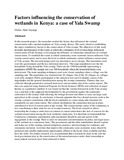| dc.description.abstract | In this research project, the researcher studied the factors that influenced the wetland conservation with a special emphasis on Yala swamp, Kenya. The study aimed at establishing the major contributory factors to the conservation of Yala swamp. The objectives of this study included determination of the extent at which the community level of knowledge influenced conservation ofYala Swamp; to investigate the influence of community attitude has on wetland conservation; To establish the extent at which community socio economic factors influence Yala swamp conservation; and to asses the level at which community culture influence conservation of Yala swamp.
The research design used was descriptive survey design. The instruments used were the questionnaire and the key informant interview. The target population were the the households living around the Yala swamp. These are the 1500 households representing a population of9000.The sample size was 300 households where the household heads were interviewed.
The main sampling techniques used were cluster sampling where a village was the sampling unit. The population was clustered into 20 villages. Out of the 20 villages, six villages were fully sampled. Public participation is the analytical tool used to identify causes of the degradation and the general dissatisfaction among the swamp community. Primary data was collected through quantitative research interviews and secondary data from various reports. The data was analyzed using Statistical Program for Social Sciences (SPSS) and collection of major themes as a qualitative method. It was found out that the current destruction at the Yala swamp was a reaction to the supposed discrimination by the government against the community cultivation of the swamp while allowing the foreign investor and others to carry out large scale agriculture at the swamp.
In conclusion, it became apparent that for a shared resource such as the swamp, a proper consultation with the local community is a must along side education for sustainable use and conservation. The cultural mechanisms the community had put in place contributed to level of conservation at the swamp. The socioeconomic status of the community is low contributing to their need for use of swamp resources. The local councils in whose trusteeship the swamp is under have no interest in conservation hence the lack of concern for the wetland conservation among the local Authority employees. It is therefore recommended that Continuous community participation and consultation should be part and parcel of the engagement at the swamp. There is need for education and information on policy and legal issues of the wetland on a continuous basis.
The government and the other stakeholders should explore and make use of the existing cultural indigenous practices and knowledge for continuity and community inclusion. Activities that improve the community socio-economic status should be promoted and suitable employment opportunities offered to the locals when available and they have the skills. For further research, it is recommended that a research be done on the role the local government play in the conservation of the natural resources under their trusteeship as many natural resources have been entrusted to them. | en_US |

